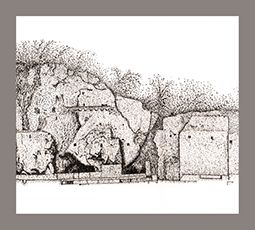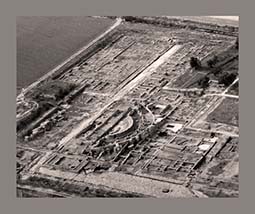Author: A. Caruso
Download article as .pdf: Le grotte e la stoà di Mieza-Izvoria. Dati per un’esegesi storica, archeologica e funzionale
 At Izvoria, few km far from the ancient Mieza (Macedonia), in 1965 the Greek archaeologist Ph. Petsas brought to light a L-shaped stoà. He supposed that in this building Aristotle taught the young Alexander, during his teaching near Mieza, which is attested in Plutarch’s Life of Alexander. Two natural grottoes lie next to the stoa. Both the grottoes were monumentalized in antiquity, by inserting architraves, niches, large steps and pilasters. Here I offer a different interpretation of the stoa and grottoes function, thanks to a reexamination of all the available data (the environment, the building, the other testimonies). In my opinion, Aristotle taught Alexander mainly at Pella, and came to this place for specific activities and lessons. In this regard, it is worth nothing another testimony from Plutarch: that Aristotle transmitted to Alexander also secret and mysteric doctrines (akroamatikes and epoptikes). I suggest that these lessons have taken place inside the grottoes, while the stoa worked as storage of objects, as well as artificial support for reaching the cave above it: it would therefore have been a complement to the area, not the fulcrum, as it has been supposed before. If my interpretation is correct, the Izvoria caves would provide archaeological evidence to the theme of intellectual activities inside grottoes, a promising theme, involving education and religion, which is attested in the literary tradition, but scarcely documented from archaeology.
At Izvoria, few km far from the ancient Mieza (Macedonia), in 1965 the Greek archaeologist Ph. Petsas brought to light a L-shaped stoà. He supposed that in this building Aristotle taught the young Alexander, during his teaching near Mieza, which is attested in Plutarch’s Life of Alexander. Two natural grottoes lie next to the stoa. Both the grottoes were monumentalized in antiquity, by inserting architraves, niches, large steps and pilasters. Here I offer a different interpretation of the stoa and grottoes function, thanks to a reexamination of all the available data (the environment, the building, the other testimonies). In my opinion, Aristotle taught Alexander mainly at Pella, and came to this place for specific activities and lessons. In this regard, it is worth nothing another testimony from Plutarch: that Aristotle transmitted to Alexander also secret and mysteric doctrines (akroamatikes and epoptikes). I suggest that these lessons have taken place inside the grottoes, while the stoa worked as storage of objects, as well as artificial support for reaching the cave above it: it would therefore have been a complement to the area, not the fulcrum, as it has been supposed before. If my interpretation is correct, the Izvoria caves would provide archaeological evidence to the theme of intellectual activities inside grottoes, a promising theme, involving education and religion, which is attested in the literary tradition, but scarcely documented from archaeology.
 A strong modern tradition links Hippodamus of Miletos to Thurioi, a new-founded city where archeology has unveiled a new and interesting city-planning. Nevertheless the ancient sources are rather confused about Hippodamus’ relationship with Thurioi, especially Hesychius, whose corrupted text is here taken into account for a new reading.
A strong modern tradition links Hippodamus of Miletos to Thurioi, a new-founded city where archeology has unveiled a new and interesting city-planning. Nevertheless the ancient sources are rather confused about Hippodamus’ relationship with Thurioi, especially Hesychius, whose corrupted text is here taken into account for a new reading.
